BMW 5 Series (E39)
| BMW 5 Series (E39) | |
|---|---|
_Executive_sedan_(2010-10-02)_01.jpg) | |
| Overview | |
| Manufacturer | BMW |
| Production | 1995–2003 |
| Assembly |
Dingolfing, Germany Toluca, Mexico (CKD) Kaliningrad, Russia (CKD) |
| Designer | Joji Nagashima |
| Body and chassis | |
| Class | Executive car (E)[1] |
| Body style |
4-door sedan 5-door wagon/estate |
| Layout | FR layout |
| Powertrain | |
| Engine |
Petrol: 2.0 – 2.8 L M52 I6 2.2 – 3.0 L M54 I6 3.5–4.4 L M62 V8 4.9 L S62 V8 Diesel: 2.0 L M47 turbo I4 2.5 L M51 turbo I6 2.5 – 2.9 L M57 turbo I6 |
| Dimensions | |
| Wheelbase | 2,830 mm (111.4 in) |
| Length |
sedan: 4,775 mm (188.0 in) wagon: 4,806 mm (189.2 in) |
| Width | 1,800 mm (70.9 in) |
| Height |
sedan: 1,435 mm (56.5 in) wagon: 1,440 mm (56.7 in) |
| Curb weight | 1,480–1,800 kg (3,260–3,970 lb) |
| Chronology | |
| Predecessor | BMW 5 Series (E34) |
| Successor | BMW 5 Series (E60) |
The BMW E39 is the fourth generation of BMW 5 Series, which was sold from 1995 to 2003. It was launched in the sedan body style, with the wagon/estate body style (marketed as "Touring") introduced in 1996. The E39 was replaced by the E60 in 2003, however E39 Touring models remained in production until December 2003.[2]
The proportion of chassis components using aluminium significantly increased for the E39, and it was the first 5 Series to use aluminium components in the front suspension. It was also the first 5 Series where a four-cylinder diesel engine was available. Rack and pinion steering was used for the first time in a 5 Series, being fitted to the E39 four-cylinder and six-cylinder models. Unlike its E34 predecessor and E60 successor, the E39 was not available with all-wheel drive.
The M5 sedan was introduced in 1998, powered by the 4.9-litre S62 V8 engine.
Development and launch
Development for the E34's successor began in 1989, (internally known as "Entwicklung 39") and ended in 1995. The final design by Joji Nagashima was selected in June 1992[3][4] and later frozen for production under new design chief Chris Bangle. With design selection in 1992, the series development phase began and took 39 months till start of production. The domestic German design patent was filed on 20 April 1994, utilizing an E39 prototype.[5]
The first pilot production models were built in February 1995, with full-scale production starting later in the year.[6] Most cars were built at the Dingolfing factory,[7](p40,46–48) with complete knock-down assembly used in Mexico[8] and Russia.[9]
In May 1995 BMW published the first official photos of the E39.[10] The E39 premiered in September 1995 at the Frankfurt Motor Show.[11][12] In December 1995 sales of sedan models began on the European mainland.[13] Production of wagon/estate models began in November 1996.[14](p7)
Design
Body styles
 E39 Sedan- front
E39 Sedan- front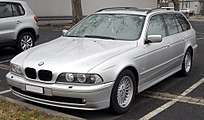 E39 Touring- front
E39 Touring- front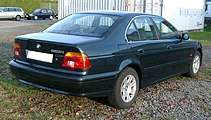 E39 Sedan- rear
E39 Sedan- rear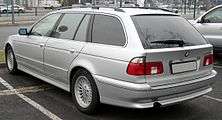 E39 Touring- rear
E39 Touring- rear
Equipment

A "latent heat accumulator" was available as an option up until September 1999.[15][16] The accumulator stores engine heat by converting a salt from a solid to a liquid form (Phase transition).[17][18] The insulated tank can store heat for several days. The next time the vehicle is started, this heat is automatically used to reduce exhaust emissions (by heating the engine up to operating temperature quicker), for cabin heating and window defrosting.[19]
Separate to the latent heat accumulator is the Residual Heat function (activated by a button labelled "REST"), [20](p104) which allows the demister and cabin heater to use the heat of an engine that has recently been turned off (using an electric pump to push hot coolant through the heater core).
The E39 was one of the first vehicles (alongside the E38 7 Series) to have curtain airbags, which protect the occupants heads in a side impact.[21]
Standard equipment on the launch models included dual front and side airbags, pretensioners and load limiters for the front seatbelts,[22] anti-lock brakes, traction control, power steering, and air conditioning.[23][24] Satellite navigation was also available, initially using maps on CD, then moving to DVD maps in 2002.
Steering
Unusually, two different steering systems were used for the E39, depending on the engine. Models with four-cylinder and six-cylinder models use rack and pinion steering,[25] the first time this system has been used in a 5 Series. This system steers from the front of the axle.[26] Models with V8 engines use recirculating ball steering, as per the previous generations of 5 Series.[26]
Chassis and body
Compared with its E34 predecessor, the E39 wheelbase grew by 68 mm (2.7 in) and overall length by 55 mm (2.2 in). Torsional rigidity was increased over the E34 by 40 percent, which reduces body flex and allows the suspension to operate more accurately, also improving ride quality.[26] Due to a stiffer body shell, the weight of the chassis increased by 10 kg (22 lb),[27] which is offset by the reduced weight of some aluminium suspension components.
Structural dynamics was also an objective of the body design, so the body's frequencies for torsional twisting and bending are in separate ranges and above natural frequency. These frequencies are out of the range of engine and driveline vibrations, to avoid vibrations being amplified.[26]
Suspension
The E39 was the first 5 Series to use aluminium components in the front suspension. The proportion of chassis components using aluminium significantly increased for the E39.[7]
The front suspension consists of MacPherson struts,[28][29] with six-cylinder cars using an aluminium front subframe. Aluminium is used for the steering knuckles, outer strut tube and the spring pads, resulting in a weight saving of 21 kg (46 lb).[26] V8 models also use aluminium in the steering box and several suspension links,[26] to compensate for the heavier steel subframe.
The rear suspension consists of a four link design (called "Z-link"), which is similar to the system used by the E38 7 Series. The design minimises unintentional toe angle changes, which increases the stability of the handling.[26]
Engines
At launch, the petrol engines consisted of the M52 straight-six and M62 V8,[30] which were both new engines at the time. In 1998, the "technical update" (TU) versions of these engines were introduced, which introduced double VANOS to increase torque at low rpm.[31] At the 2000 facelift (LCI), the M52 straight-six engine was replaced by its successor the M54, however the M62TU remained in use for the V8 models.[32] The M54B30 (in the E46 330i and E39 530i) topped the Ward's 10 Best Engines list in 2002 and 2003.[33]
The initial diesel models used the M51 straight-six turbo-diesel engine. In 1998, its successor the M57 was introduced, however the M51 also remained in production for two more years. In 1999, the M47 four-cylinder turbo-diesel was introduced in the 520d model, which is the only E39 model to use a four-cylinder engine.[34]
Drivetrain
Manual transmissions
- 5-speed ZF S5-39DZ[35] (525d,530d)
- 5-speed S5D 250G (523i,528i from 1996, 520i, 525i)
- 5-speed S5D 260Z (525td)
- 5 speed S5D 320Z (523i up to 1996, 530i, 535i)
- 6-speed Getrag 420G[35] (540i, M5)
Automatic transmissions
- 4-speed GM 4L30-E (A4S270R)[36] (523i and 528i- up to 1999)
- 5-speed GM 5L40-E (A5S360R) [36] (523i and 528i- 1999–2000)
- 5-speed GM 5L40-E (A5S390R)[36] (520i, 525i, 530i and 530d)
- 5-speed ZF 5HP19 (A5S325Z) [36] (523i, 525i, 528, 530i)
- 5-speed ZF 5HP24 (A5S440Z)[36] (540i after 1996, 535i)
- 5-speed ZF 5HP30 (A5S560Z)[37] (540i model- 1996 only)
Note that the 523i, 525i, 528i and 530i had several overlapping automatic transmission options for some years.
Models
Petrol engines
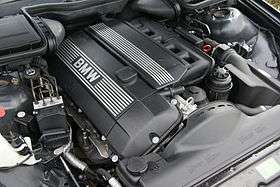

| Model | Years | Engine | Power | Torque |
|---|---|---|---|---|
| 520i | 1995–1998 | M52B20 I6 | 110 kW (148 bhp) @ 5900 rpm | 190 N⋅m (140 ft⋅lbf) @ 4200 rpm |
| 1998–2000 | M52TUB20 I6 | 110 kW (148 bhp) @ 5900 | 190 N⋅m (140 ft⋅lbf) @ 3500 rpm | |
| 2000–2003 | M54B22 I6 | 125 kW (168 bhp) @ 6100 rpm | 210 N⋅m (150 ft⋅lbf) @ 3500 rpm | |
| 523i | 1995–1998 | M52B25 I6 | 125 kW (168 bhp) @ 5500 rpm | 245 N⋅m (181 ft⋅lbf) @ 3950 rpm |
| 1998–2000 | M52TUB25 I6 | 125 kW (168 bhp) @ 5500 rpm | 245 N⋅m (181 ft⋅lbf) @ 3500 rpm | |
| 525i | 2000–2003 | M54B25 I6 | 141 kW (189 bhp) @ 6000 rpm | 245 N⋅m (181 ft⋅lbf) @ 3500 rpm |
| 528i | 1995–1998 | M52B28 I6 | 142 kW (190 bhp) @ 5300 rpm | 280 N⋅m (210 ft⋅lbf) @ 3950 rpm |
| 1998–2001 | M52TUB28 I6 | 142 kW (190 bhp) @ 5500 rpm | 280 N⋅m (210 ft⋅lbf) @ 3500 rpm | |
| 530i | 2000–2003 | M54B30 I6 | 170 kW (228 bhp) @ 5900 rpm | 300 N⋅m (220 ft⋅lbf) @ 3500 rpm |
| 535i | 1996–1998 | M62B35 V8 | 173 kW (232 bhp) @ 5700 rpm | 320 N⋅m (240 ft⋅lbf) @ 3300 rpm |
| 1998–2003 | M62TUB35 V8 | 180 kW (241 bhp) @ 5800 rpm | 345 N⋅m (254 ft⋅lbf) @ 3800 rpm | |
| 540i | 1995–1998 | M62B44 V8 | 210 kW (282 bhp) @ 5700 rpm | 420 N⋅m (310 ft⋅lbf) @ 3900 rpm |
| 1998–2003 | M62TUB44 V8 | 210 kW (282 bhp) @ 5400 rpm | 440 N⋅m (320 ft⋅lbf) @ 3600 rpm | |
| M5 | 1998–2003 | S62B50 V8 | 294 kW (394 bhp) @ 6600 rpm | 500 N⋅m (370 ft⋅lbf) @ 3800 rpm |
Figures shown are for European models.[38] (p18),[39](p40),[40]
Diesel engines
| Model | Years | Engine | Power | Torque |
|---|---|---|---|---|
| 520d | 2000–2003 | M47D20 I4 | 100 kW (134 bhp) @ 4000 rpm | 280 N⋅m (210 ft⋅lbf) @ 1750 rpm |
| 525d | 2000–2003 | M57D25 I6 | 120 kW (161 bhp) @ 4000 rpm | 350 N⋅m (260 ft⋅lbf) @ 2000 rpm |
| 525td | 1996–2000 | M51D25 UL I6 | 85 kW (114 bhp) @ 4800 rpm | 230 N⋅m (170 ft⋅lbf) @ 1900 rpm |
| 525tds | 1996–2000 | M51D25TU OL I6 | 105 kW (141 bhp) @ 4600 rpm | 280 N⋅m (210 ft⋅lbf) @ 2200 rpm |
| 530d | 1998–2000 | M57D30 I6 | 135 kW (181 bhp) @ 4000 rpm | 390 N⋅m (290 ft⋅lbf) @ 1750 rpm |
| 2000–2003 | M57D30 I6 | 142 kW (190 bhp) @ 4000 rpm | 410 N⋅m (300 ft⋅lbf) @ 1750 rpm |
Figures shown are for European models.[38](p18),[39](p40),[40]
North American model range
From 1997–1998, the E39 model range in North America consisted of the 528i and 540i, In 1999 the M5 was introduced. In 2001, the 528i was discontinued and replaced by the 525i and 530i.
In 2001, the American market 540i's power output was increased to 216 kW (290 hp),[41] unlike other markets where the 540i's power remained at 210 kW (282 hp).[42]
M5 version
.jpg)
_-_Flickr_-_The_Car_Spy_(15).jpg)
The M5 version of the E39 was Introduced in 1998 at the Geneva Motor Show and was produced from 1998 to 2003. It was powered by the S62 V8 engine. All E39 M5 cars were sold in the sedan body style with a 6-speed manual transmission.
Special models
Alpina B10 and D10
The petrol engined Alpina B10 3.2, 3.3, V8 and V8S models were built as sedans and wagons based on the E39 from January 1997 to May 2004.[43]
In February 2000, Alpina introduced the Alpina D10 Biturbo, the first six-cylinder diesel model produced by Alpina. The engine, a 3.0 liter twin turbocharged unit with 180 kW (245 HP) and 500 Nm of torque, was based on the engine of the BMW 530d.[43]
Protection line
The 540i Protection light-armored vehicle was launched in Europe in September 1997 and in North America from January 1998.[44] These models included aramid fiber armor, bullet-resistant glass that is coated with polycarbonate to reduce spall. The 540i Protection is rated to withstand the impact of handgun fire up to and including .44 Magnum,[45] the glass is also protected from attack with blunt objects such as baseball bats and bricks.[46] The additional security measures brought an additional weight of 130 kg compared to the normal 540i sedan.[47] on request, an intercom system was available and from January 1998 a run-flat tire was available.[45]
Model year changes
Most changes occur in September each year, when the changes for the following model year go into production, as is typical BMW practice. Therefore, the changes for 1996 represent the 1997 model year, for example.
1996
- Wagon/Estate body style (called Touring) introduced.
- 525td model introduced.
1997
- On-board computer upgraded.
- Cornering Brake Control introduced.
- Rear side airbags introduced.
- Sport Package introduced.
- Automatic transmission option introduced for 540i.
- North American sales commence, starting with the 528i and 540i models.
1998
- M5 model introduced.[48] Lower-body rear side airbags were standard on the M5, remaining optional for other models.
- M52 straight-six engines updated to M52TU.[49]
- M62 V8 engines updated to M62TU.[50]
- 530d model introduced, using the new M57 straight-six turbo-diesel engine.
- Xenon headlights introduced.
- Parking sensors ("Park Distance Control") introduced.
- Self-levelling rear suspension introduced for Estate models.
- Stability control upgraded (from ASC+T to DSC).
- Sport Package replaced by "M Sport" package.
- Self-Adjusting Clutch (SAC) introduced on the straight-six petrol engines.
- Satellite navigation upgraded from MKI (or Mark I) to MKII.[51][52] Like the MKI, the MKII uses a 4:3 screen and stores the maps on a CD.
1999
- Rain-sensing windshield wipers introduced (June 1999)[53]
- Front seat airbags upgraded to dual stage[54]:page 5
2000 facelift
The E39 facelift (also known as LCI) models were introduced in the 2001 model year (produced from September 2000).
- 520i, 525i and 530i models (using M54 engines) replace the 523i and 528i model (M52TU engines).
- 525d model (using M57 engine) replaces the 525td model (M51 engine).
- 530d model receives power increase.
- 520d introduced, powered by a four-cylinder diesel engine.
- Revised "angel eye" headlights.[55]
- Revised tail lights with LED brake lights.
- Navigation screen updated from 4:3 to larger 16:9 widescreen.[56]
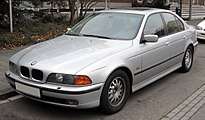 Pre-facelift front
Pre-facelift front.jpg) Post-facelift front
Post-facelift front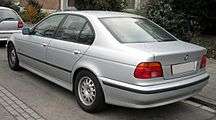 Pre-facelift rear
Pre-facelift rear_Executive_sedan_(2011-11-17).jpg) Post-facelift rear
Post-facelift rear
2001
- Automatic transmission cars had the manual shift direction switched (to forwards for downshifts, backwards for upshifts).
- Automatic headlights introduced.
- 540i power increased from 210 kW (282 hp) to 216 kW (290 hp) in the American market.[54]:page 12
- In-dash CD player becomes standard equipment on all models.[54]:page 12
- Power passenger seat becomes standard on 6 cylinder models and automatic climate control becomes standard on 525i.[57]
2002
- Navigation upgraded from CD-ROM format (8 CDs to cover the United States and Canada) to a single DVD-ROM.[58]
2003
- 540i M-sport limited edition model produced.
- Additional chrome trim added on the trunk (boot) and on the sides of the body.
Production and sales
May 2000 – May 2001 sales of the series in the United States was 15,233. May 1999 – May 2000 sales in the United States was 19,294.[59]
Motorsport
The M5 was used by several teams in the Italian Superstars Series.[60]
Awards
Car and Driver often featured the E39 in its "10Best list".[61] The E39 BMW 5 Series was considered the benchmark of its class[62] and Consumer Reports gave the 2001 530i its highest car rating ever, declaring the 2002 BMW E39 the best car they had ever reviewed.[63] Other reviewers have also praised the E39 models.[64][65][66][67][68]
Safety
| Adult Occupant: | |
| Pedestrian: |
The series tested for IIHS's "moderate overlap front" test and received 'Good' rating results, the highest available.[70]
References
- ↑ "1995 BMW 523i Steptronic specifications". www.automobile-catalog.com. Retrieved 7 December 2017.
- ↑ Annual Report 2004 (PDF). Bayerische Motoren Werke Aktiengesellschaft. p. 13. Retrieved 24 April 2017.
- ↑ "BMW E39: Joji Nagashima – die Übergangslösung". www.auto-motor-und-sport.de. Retrieved 7 March 2017.
- ↑ "Bavarian Dreams: The 10 Best Designed BMWs of All Time". www.au.complex.com. Retrieved 7 March 2017.
- ↑ "Registerauskunft zum Design Designnummer: M9403410-0001". Deutsches Patent- und Markenamt. Retrieved 12 April 2017.
- ↑ "BMW E39". www.bmwarchive.org. Retrieved 4 March 2018.
- 1 2 "BMW Geschäftsbericht 1995" (PDF). www.bmw-grouparchiv.de (in German). Bayerische Motoren Werke Aktiengesellschaft. 14 February 2016. Retrieved 20 January 2017.
- ↑ Jacobs, A. J. (2015). The New Domestic Automakers in the United States and Canada: History, Impacts, and Prospects. Lexington Books. p. 259. ISBN 9780739188262. Retrieved 7 December 2017.
- ↑ "Группа компаний Автотор :: Автомобили BMW". www.avtotor.ru. Archived from the original on 8 December 2002.
- ↑ "Die neue BMW 5er-Reihe: vom Original zum Meisterstück in der oberen Mittelklasse". www.bmw-grouparchiv.de. Retrieved 17 January 2017.
- ↑ "BMW TAKES A LOOK BACK AT ALL PREVIOUS 5 SERIES GENERATIONS". www.motor1.com. Retrieved 17 January 2017.
- ↑ "1998 – 2003 BMW 5-Series". TopSpeed.
- ↑ Preise BMW 5er Limousine (Die neue BMW 5er Reihe) (PDF). Bayerische Motoren Werke. Retrieved 17 January 2017.
- ↑ "Fast Facts April 2008" (PDF). www.bmweducation.co.uk. Archived from the original (pdf) on 12 September 2012.
- ↑ "5' E39 528i Latent heat accumulator". www.realoem.com. Retrieved 20 January 2017.
- ↑ Vasiliev, Leonard L. (2000). "Latent heat storage modules for preheating internal combustion engines: application to a bus petrol engine". Applied Thermal Engineering. 20: 913–923. Retrieved 3 March 2018.
- ↑ BMW E39 Owner's Handbook for the vehicle. Germany: BMW. 1998. p. 159.
- ↑ ""Latent heat store", explain please!!?". www.bmw5.co.uk. Retrieved 20 January 2017.
- ↑ "Neue 5er-Reihe; Z3" (PDF). bmw-grouparchiv.de (in German). Bayerische Motoren Werke Aktiengesellschaft. 1995-06-09. Retrieved 20 January 2017.
- ↑ User manuals for E39 5 Series (in German). BMW AG. July 1998. Retrieved 6 April 2017.
- ↑ "5 Series Video Handbook". www.youtube.com. BMW North America. Retrieved 20 November 2017.
- ↑ "5er absolviert US-Crashtest als bestes Fahrzeug". www.bmw-grouparchiv.de (in German). Retrieved 23 February 2017.
- ↑ "1996 BMW 528i". www.redbook.com.au. Archived from the original on 21 August 2011.
- ↑ "1996 BMW 540i". www.redbook.com.au. Red Book. Archived from the original on 21 August 2011.
- ↑ "Bent-Eight Beemer". www.autospeed.com.au. Archived from the original on 21 September 2007.
- 1 2 3 4 5 6 7 "Professional Development Department E39 Introduction". BMW of North America, Inc. 1996.
- ↑ "BMW E39 5-Series (1996-03)". www.carpoint.com.au. Archived from the original on 10 November 2007.
- ↑ "BMW E39 M5 Performance Parts @ Custom Performance Innovations". www.custom-performance.net. Retrieved 20 January 2017.
- ↑ "DIY: Front Strut Replacement". www.bimmerforums.com. Retrieved 20 January 2017.
- ↑ "1997 BMW 5 Series – European Car". www.motortrend.com. Retrieved 14 February 2017.
- ↑ "VANOS". www.usautoparts.net. Archived from the original on 2014-07-24.
- ↑ "Procedures – M62TU Vanos Procedure". www.beisansystems.com. Retrieved 27 January 2017.
- ↑ Bill Visnic (2003-01-01). "10 Best Engines | News & Analysis content from". WardsAuto. Retrieved 2016-07-17.
- ↑ "BMW E39 Specifications". www.bmwinfo.com. Retrieved 27 January 2017.
- 1 2 Larimer, Fred (2002). BMW Buyer's Guide. MotorBooks International. p. 154. ISBN 0-7603-1099-8.
- 1 2 3 4 5 "Electronic Transmission Control" (PDF). www.e38.org. Retrieved 2015-03-25.
- ↑ "BMW Transmission and Oil Application Chart – BMW Doc SD 92–113" (PDF). www.europeantransmissions.com. Retrieved 3 March 2018.
- 1 2 "BMW 5 Series saloon". Munich: BMW AG. 2003.
- 1 2 "Der BMW 5er Limousine" (in German). 1998. Retrieved 6 April 2017.
- 1 2 "Autoweek Carbase for BMW 5-series". www.autoweek.nl (in Dutch). Archived from the original on 9 August 2007.
- ↑ "540i 6-speed sedan Technical Data". www.bmwusa.com. Archived from the original on 18 December 2001.
- ↑ "2001 BMW 540 (for Europe) specs". www.automobile-catalog.com. Retrieved 11 April 2017.
- 1 2 "ALPINA Automobiles based on BMW 5 Series E39". www.alpina-automobiles.com. Retrieved 28 June 2017.
- ↑ "BMW introduces $88,000 bulletproof car". CNN. Retrieved 12 April 2017.
- 1 2 "BMW Ballistic Protection". bmw-ids.com. Archived from the original on 13 February 2003. Retrieved 23 April 2017.
- ↑ Popular Science. February 1998. p. 26.
- ↑ BMW definiert neues Marktsegment. BMW AG. 23 June 1997. Retrieved 12 April 2017.
- ↑ "2001 BMW M5 Review". www.jbcarpages.com. Retrieved 2011-04-03.
- ↑ "Information on M52 engines". www.bmwheaven.com. Retrieved 21 February 2017.
- ↑ "Information on M62 engines". www.bmwheaven.com. Retrieved 21 February 2017.
- ↑ "65908364421 RMFD NAVIGATION CD COMPUTER MK I". www.realoem.com. Retrieved 21 February 2017.
- ↑ "65906908313 RMFD NAVIGATION CD COMPUTER MK II". www.realoem.com. Retrieved 21 February 2017.
- ↑ "E39 FAQs/ Links/ Autoparts/ 528i links". www.bimmerforums.com. Retrieved 25 February 2017.
- 1 2 3 BMW E39 5 Series 1997–2002 Model Year Changes. www.archive.org. Retrieved 19 February 2017.
- ↑ "97-00 BMW E39 5 Series Facelift Lighting". www.e39source.com. Retrieved 3 March 2017.
- ↑ "65906908313 RMFD NAVIGATION CD COMPUTER MK II". www.realoem.com. Retrieved 19 February 2017.
- ↑ "2002 BMW 5-Series Review". www.jbcarpages.com. Retrieved 3 April 2011.
- ↑ "MKIV". www.bimmernav.com. Retrieved 2010-10-03.
- ↑ "BMW GROUP NA SALES MAY 2001: BMW SALES CONTINUE AT RECORD LEVELS; May Sales Soar 32 Percent and Year-to-Date Sales Jump 18 Percent". BMW Group.
- ↑ "Italian Superstars Championship 2007 – The grid: Photo 20 / 20". ; "Italian Superstars Championship 2007 – The grid: Photo 9 / 20". ; "#56 Todi Corse BMW M5(e39): Leonardo Baccarelli". ; "#58 Todi Corse BMW M5 (e39): Marco Gregori".
- ↑ "2011 BMW 5-series / 528i / 535i / 550i – Official Photos and Info – Auto Reviews". Car and Driver. Retrieved 2010-09-12.
- ↑ "2002 BMW 5-Series Review". JB car pages. Retrieved 2011-04-03.
- ↑ "Consumer Reports Article – 530i Best Ever". www.roadfly.com. Archived from the original on 6 March 2017.
- ↑ "Used BMW 5 Series review: 1996–2003". CarsGuide.
- ↑ "Top Gear's greatest ever car? A BMW banger that cost £1500". Telegraph.
- ↑ "Is the E39 5 Series the best car ever made?". BMW Blog.
- ↑ "Future Classic Friday: BMW 5-Series E39". Honest John.
- ↑ "The Clarkson review: BMW 528i Touring SE (1999)". The Sunday Times Driving.
- ↑ "BMW 5 Series (1998)". www.euroncap.com.
- ↑ "2003 BMW 5 series". IIHS.
« previous — BMW cars: 1980s to 2000s — next » | |||||||||||||||||||||||||||||||||||
|---|---|---|---|---|---|---|---|---|---|---|---|---|---|---|---|---|---|---|---|---|---|---|---|---|---|---|---|---|---|---|---|---|---|---|---|
| Series | 1980s | 1990s | 2000s | ||||||||||||||||||||||||||||||||
| 0 | 1 | 2 | 3 | 4 | 5 | 6 | 7 | 8 | 9 | 0 | 1 | 2 | 3 | 4 | 5 | 6 | 7 | 8 | 9 | 0 | 1 | 2 | 3 | 4 | 5 | 6 | 7 | 8 | 9 | ||||||
| 1 Series | E87>> | ||||||||||||||||||||||||||||||||||
| 3 Series | <<E21 | E30 | E36 | E46 | E90>> | ||||||||||||||||||||||||||||||
| 5 Series | <<E12 | E28 | E34 | E39 | E60>> | ||||||||||||||||||||||||||||||
| 6 Series | <<E24 | E63>> | |||||||||||||||||||||||||||||||||
| 7 Series | <<E23 | E32 | E38 | E65 | F01>> | ||||||||||||||||||||||||||||||
| 8 Series | E31 | ||||||||||||||||||||||||||||||||||
| Z Series | Z1 | Z3 | Z4 (E85) | Z4 (E89>> | |||||||||||||||||||||||||||||||
| Z8 | |||||||||||||||||||||||||||||||||||
| Wikimedia Commons has media related to BMW E39. |